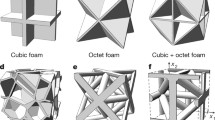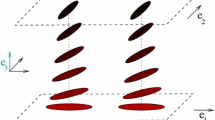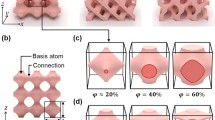Abstract
When thin nanomaterials spontaneously deform into nonflat geometries (e.g, nanorods into nanohelices, thin sheets into ruffled forms), their properties may change by orders of magnitude. We discuss this phenomenon in terms of a formal mathematical concept: codimension c = D - d, the difference between the dimensionality of space D, and that of the object d. We use several independent examples such as the edge stress of graphene nanoribbons, the elastic moduli of nanowires, and the thermal expansion of a modified bead-chain model to demonstrate how this framework can be used to generically understand some nanomaterial properties and how these properties can be engineered by using mechanical constraints to manipulate the codimension of the corresponding structure.






Similar content being viewed by others
References
S. Iijima: Helical microtubules of graphitic carbon Nature 354, 56 (1991).
H. Dai: Carbon nanotubes: Synthesis, integration, and properties Acc. Chem. Res. 35, 1035 (2002).
X. Duan and C.M. Lieber: General synthesis of compound semiconductor nanowires Adv. Mater. 12, 298 (2000).
Y. Wu, J. Xiang, C. Yang, W. Lu, and C.M. Lieber: Single-crystal metallic nanowires and metal/semiconductor nanowire heterostructures Nature 430, 61 (2004).
A.K. Geim and K.S. Novoselov: The rise of graphene Nat. Mater. 6, 183–191 (2007).
X.Y. Kong and Z.L. Wang: Spontaneous polarization-induced nanohelixes, nanosprings, and nanorings of piezoelectric nanobelts Nano Lett. 3, 1625–1631 (2003).
Z.W. Pan, Z.R. Dai, and Z.L. Wang: Nanobelts of semiconducting oxides Science 291, 1947–1949 (2001).
K.V. Bets and B.I. Yakobson: Spontaneous twist and intrinsic instabilities of pristine graphene nanoribbons Nano Res. 2, 161–166 (2009).
J.M. Garci-Rauiz, E.-G. Meleroarcia, and S.T. Hyde: Morphogenesis of self-assembled nanocrystalline materials of barium carbonate and silica Science 323, 362–365 (2009).
M.H. Huang, C. Boone, M. Roberts, D.E. Savage, M.G. Lagally, N. Shaji, H. Qin, R. Blick, J.A. Nairn, and F. Liu: Nanomechanical architecture of strained bilayer thin films: From design principles to experimental fabrication Adv. Mater. 17, 2860–2864 (2005).
L. Zhang, E. Deckhardt, A. Weber, C. Schonenberger, and D. Grutzmacher: Controllable fabrication of SiGe/Si and SiGe/Si/Cr helical nanobelts Nanotechnology 16, 655–663 (2005).
M. Hazewinkel, Ed.: Encyclopaedia of Mathematics; Springer: New York; 1995.
Encyclopaedia of mathematics:http://eom.springer.de/C/c022870.htm (accessed August 11, 2011).
R. LeSar, R. Najafabadi, and D.J. Srolovitz: Thermodynamics of solid and liquid embedded-atom-method metals: A variational study J. Chem. Phys. 94, 5090–5097 (1991).
G.A. Mansoori and F.B. Canfield: Variational approach to melting. II. J. Chem. Phys. 51, 4967–4972 (1969).
J. Steinmetz, S. Kwon, H.J. Lee, E.-H. Abouamad, R. Almairac, C.-B. Gozeac, H. Kim, and Y.W. Park: Polymerization of conducting polymers inside carbon nanotubes Chem. Phys. Lett. 431, 139–144 (2006).
J. Steinmetz, H.J. Lee, S. Kwon, D.S. Lee, C.-B. Gozeac, E.-H. Abouamad, H. Kim, and Y.W. Park: Routes to the synthesis of carbon nanotube-polyacetylene composites by Ziegler-Natta polymerization of acetylene inside carbon nanotubes Curr. Appl. Phys. 7, 39–41 (2007).
D. Nishide, T. Wakabayashi, T. Sugai, R. Kitaura, H. Kataura, Y. Achiba, and H. Shinohara: Raman spectroscopy of size-selected linear polyyne molecules C2NH2 (n = 46) encapsulated in single-wall carbon nanotubes J. Phys. Chem. C 111, 5178–5183 (2007).
A.V. Bazilevsky, K. Sun, A.L. Yarin, and C.M. Megaridis: Selective intercalation of polymers in carbon nanotubes Langmuir 23, 7451–7455 (2007).
G.C. McIntosh, D. Tománek, and Y.W. Park: Energetics and electronic structure of a polyacetylene chain contained in a carbon nanotube Phys. Rev. B 67, 125419 (2003).
W. Bao, F. Miao, Z. Chen, H. Zhang, W. Jang, C. Dames, and C.N. Lau: Controlled ripple texturing of suspended graphene and ultrathin graphite membranes Nat. Nanotechnol. 4, 562–566 (2009).
J.W. Jiang, J.S. Wang, and B.W. Li: Thermal expansion in single-walled carbon nanotubes and graphene: Nonequilibrium Green’s function approach Phys. Rev. B 80, 205429 (2009).
D.Q. Zhang, A. Alkhateeb, H.M. Han, H. Mahmood, D.N. McIlroy, and M.G. Norton: Silicon carbide nanosprings Nano Lett. 3, 983–987 (2003).
A.M. Wahl: Helical compression and tension springs J. Appl. Mech. 2, A38 (1935).
C.J. Ancker Jr. and J.N. Goodier: Pitch and curvature correction for helical springs J. Appl. Mech. 25, 466 (1958).
W. Young and R. Budynas: Roar’ks Formulas for Stress & Strain, 7th ed.; McGraw-Hill Professional: New York; 1984.
M.H. Gass, U. Bangert, A.L. Bleloch, P. Wang, R.R. Nair, and A.K. Geim: Free-standing graphene at atomic resolution Nat. Nanotechnol. 3, 676–681 (2008).
L. Tapaszto, G. Dobrik, P. Lambin, and L.P. Biro: Tailoring the atomic structure of graphene nanoribbons by scanning tunnelling microscope lithography Nat. Nanotechnol. 3, 397–401 (2008).
A.K. Geim: Graphene: Status and prospects Science 324, 1530–1534 (2009).
S. Jun: Density-functional study of edge stress in graphene Phys. Rev. B 78, 073405 (2008).
B. Huang, M. Liu, N.H. Su, J. Wu, W.H. Duan, B.L. Gu, and F. Liu: Quantum manifestations of graphene edge stress and edge instability: A first-principles study Phys. Rev. Lett. 102, 166404 (2009).
C.K. Gan and D.J. Srolovitz: Trends in graphene edge properties and flake shapes: A first-principles study Phys. Rev. B 81, 125445 (2010).
V.B. Shenoy, C.D. Reddy, A. Ramasubramaniam, and Y.W. Zhang: Edge-stress-induced warping of graphene sheets and nanoribbons Phys. Rev. Lett. 101, 245501 (2008).
F.G. Rammerstorfer, F.D. Fischer, and N. Friedl: Buckling of free infinite strips under residual stresses and global tension J. Appl. Mech. 68, 399–404 (2001).
Z.G. Chen, J. Zou, G. Liu, F. Li, Y. Wang, L. Wang, X.L. Yuan, T. Sekiguchi, H.M. Cheng, and G.Q. Lu: Novel boron nitride hollow nanoribbons ACS Nano 2, 2183–2191 (2008).
J.-D. Camposelgado, J.M. Romo-Herrera, X. Jia, D.A. Cullen, H. Muramatsu, Y.A. Kim, T. Hayashi, Z. Ren, D.J. Smith, Y. Okuno, T. Ohba, H. Kanoh, K. Kaneko, M. Endo, H. Terrones, M.S. Dresselhaus, and M. Terrones: Bulk production of a new form of sp2 carbon: Crystalline graphene nanoribbons Nano Lett. 8, 2773–2778 (2008).
P.S. Branicio, C.K. Gan, M.H. Jhon, and D.J. Srolovitz: Properties on the edge: Graphene edge energies, edge stresses, edge warping, and the wulf shape of graphene flakes Model. Simul. Mater. Sci. Eng. 19, 054002 (2011).
D.W. Brenner, O.A. Shenderova, J.A. Harrison, S.J. Stuart, B. Ni, and S.B. Sinnott: A second-generation reactive empirical bond order (REBO) potential energy expression for hydrocarbons J. Phys: Condens. Matter 14, 783–802 (2002).
Y. Liu, A. Dobrinsky, and B.I. Yakobson: Graphene edge from armchair to zigzag: The origins of nanotube chirality? Phys. Rev. Lett. 105, 235502 (2010).
Q. Lu and R. Huang: Excess energy and deformation along free edges of graphene nanoribbons Phys. Rev. B 81, 155410 (2010).
G.H. Lui, L. Liu, K.F. Mak, G.W. Flynn, and T.F. Heinz: Ultraflat graphene Nature 462, 339–341 (2009).
J.F. Nye: Physical Properties of Crystals: Their Representation by Tensors and Matrices; Oxford University Press: Oxford, UK; 1984.
I.A. Ovid’ko: Nanodefects in nanostructures Phil. Mag. Lett. 83, 611–620 (2003).
M. Terrones, F. Banhart, N. Grobert, J.-C. Charlier, H. Terrones, and P.M. Ajayan: Molecular junctions by joining single-walled carbon nanotubes Phys. Rev. Lett. 89, 075505 (2002).
M.Y. Gutkin and I.A. Ovid’ko: Glide of hollow fibers at the bridging stage of fracture in ceramic nanocomposites Scripta Mater. 59, 414–417 (2008).
M.Y. Gutkin and I.A. Ovid’ko: Effect of y-junction nanotubes on strengthening of nanocomposites Scripta Mater. 61, 1149–1152 (2009).
A.G. Shtukenberg, J. Freudenthal, and B. Kahr: Reversible twisting during helical hippuric acid crystal growth J. Am. Chem. Soc. 132, 9341–9349 (2010).
H. Liang and L. Mahadevan: The shape of a long leaf Proc. Natl. Acad. Sci. 106, 22049–22054 (2009).
D.C. Liu and J. Nocedal: On the limited memory BFGS method for large-scale optimization Math. Program. 45, 503–528 (1989).
Acknowledgments
The authors gratefully acknowledge Prof. M. Haataja, Prof. Y.W. Zhang, Prof. S. Safran, Prof. C. Arnold, Dr. C.K. Gan, and Dr. C. Majidi for enlightening discussions and comments.
Author information
Authors and Affiliations
Corresponding author
Appendix A: Calculation of Graphene Edge Energy and Stress
Appendix A: Calculation of Graphene Edge Energy and Stress
GNR edge energy and stress are calculated in a similar manner as Jun30 and Gan and Srolovitz.32 The edge energy (per unit length) Ee as a function of edge orientation a is defined as
where \(E_\text{GNR}^N\left( \alpha \right)\) is the total energy of a GNR with N atoms, length L, and edge orientation a, and EB is the energy per atom in a bulk (infinite) flat graphene sheet. The factor of 2 in the denominator of Eq. (A1) accounts for the fact that a GNR has two (parallel) edges. For narrow GNRs, Ee(α) depends on the GNR width because of interactions between the edges. This effect decays rapidly with GNR width. Therefore, we perform simulations on GNRs of widths in excess of 100 Å for which Ee(α) reaches the asymptotic value for large widths.
For all edge types, Ee(α) was calculated by minimizing the total energy with respect to all atomic coordinates at T = 0. We employed the limited-memory Broyden–Fletcher–Goldfarb–Shanno49 method to relax the atomic structures (both in c = 0 and 1) until it converged to within 10–10 eV/atom. In the c = 1 case, noise was added to the initial atomic positions (i.e., perturbations in the atom positions from the flat structure) in order to break the symmetry of the problem.
We calculate the edge stress τe by straining the equilibrium (zero stress) GNR and interpolating the resultant system energy versus strain curve at ∈ = 0. For c = 0, both compressive and tensile strains were employed, for c = 1, where the GNR buckles out of plane for compressive strains, only tensile strains were applied in order to determine τe.
Rights and permissions
About this article
Cite this article
Branicio, P.S., Jhon, M.H. & Srolovitz, D.J. Engineering materials properties in codimension > 0. Journal of Materials Research 27, 619–626 (2012). https://doi.org/10.1557/jmr.2011.306
Received:
Accepted:
Published:
Issue Date:
DOI: https://doi.org/10.1557/jmr.2011.306




